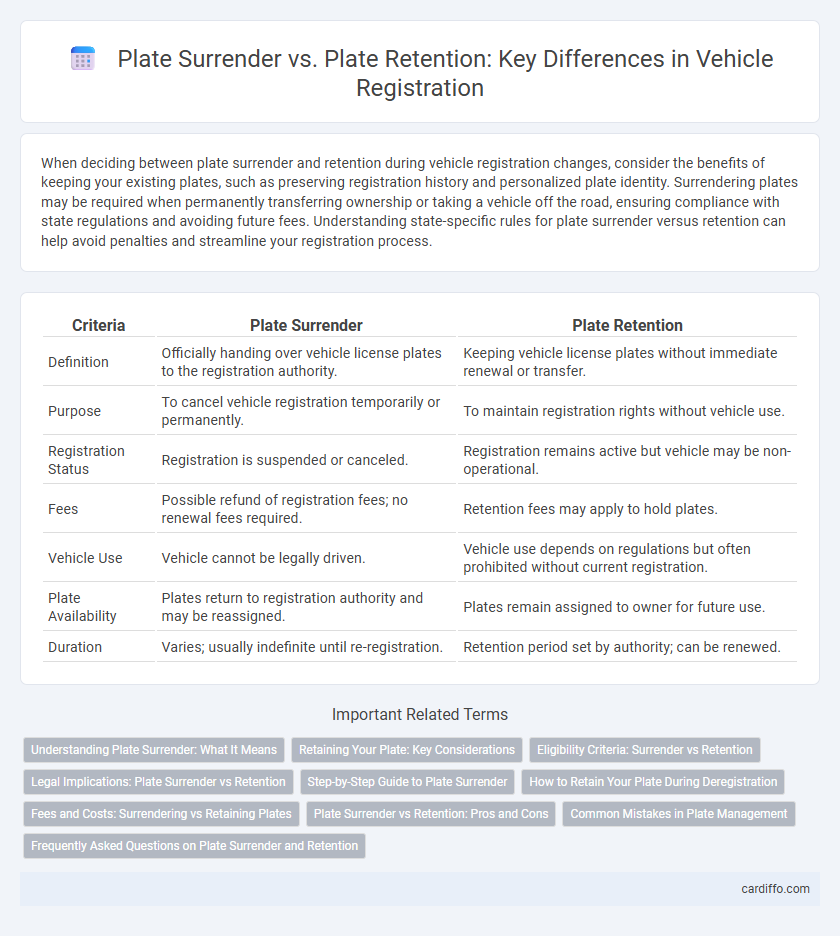When deciding between plate surrender and retention during vehicle registration changes, consider the benefits of keeping your existing plates, such as preserving registration history and personalized plate identity. Surrendering plates may be required when permanently transferring ownership or taking a vehicle off the road, ensuring compliance with state regulations and avoiding future fees. Understanding state-specific rules for plate surrender versus retention can help avoid penalties and streamline your registration process.
Table of Comparison
| Criteria | Plate Surrender | Plate Retention |
|---|---|---|
| Definition | Officially handing over vehicle license plates to the registration authority. | Keeping vehicle license plates without immediate renewal or transfer. |
| Purpose | To cancel vehicle registration temporarily or permanently. | To maintain registration rights without vehicle use. |
| Registration Status | Registration is suspended or canceled. | Registration remains active but vehicle may be non-operational. |
| Fees | Possible refund of registration fees; no renewal fees required. | Retention fees may apply to hold plates. |
| Vehicle Use | Vehicle cannot be legally driven. | Vehicle use depends on regulations but often prohibited without current registration. |
| Plate Availability | Plates return to registration authority and may be reassigned. | Plates remain assigned to owner for future use. |
| Duration | Varies; usually indefinite until re-registration. | Retention period set by authority; can be renewed. |
Understanding Plate Surrender: What It Means
Plate surrender refers to the formal process of returning vehicle license plates to the relevant motor vehicle authority when a vehicle is no longer in use, typically due to sale, disposal, or deregistration. Understanding plate surrender is crucial as it legally releases the owner from liability related to the vehicle, such as toll charges and parking fines. Retaining plates without proper use or notification may result in penalties, making timely surrender essential for compliance with registration regulations.
Retaining Your Plate: Key Considerations
Retaining your vehicle license plate requires understanding state-specific regulations, including renewal deadlines and fees to avoid penalties. Ensuring proper documentation and timely updates with the DMV maintains your plate's active status and legal validity. Failure to adhere to retention guidelines may result in losing the right to keep the plate, leading to additional costs or complications when re-registering.
Eligibility Criteria: Surrender vs Retention
Eligibility criteria for plate surrender typically require vehicle owners to permanently take their license plates out of service, such as when a vehicle is decommissioned or sold out of state. Plate retention eligibility allows vehicle owners to keep their existing plates for future use, often applicable when registering a new vehicle or during temporary non-use periods. Specific requirements vary by jurisdiction but generally include proof of ownership, valid registration, and compliance with local DMV regulations.
Legal Implications: Plate Surrender vs Retention
Surrendering a vehicle plate legally transfers its registration status back to the issuing authority, preventing further liability or fees associated with the vehicle. Retaining a plate while the vehicle is deregistered may result in ongoing legal responsibilities, including potential fines or penalties if not properly reported. Understanding local DMV regulations is crucial to ensure compliance and avoid unintended legal consequences.
Step-by-Step Guide to Plate Surrender
To surrender a vehicle plate, begin by removing the license plate from the vehicle and ensuring all outstanding fines or fees are paid. Next, visit the local Department of Motor Vehicles (DMV) office or use the online portal to submit the plate surrender form, providing vehicle details and proof of ownership. Finally, obtain a receipt as confirmation of plate surrender to avoid future liabilities or renewal charges.
How to Retain Your Plate During Deregistration
To retain your vehicle plate during deregistration, ensure you submit a formal application to the local transport authority before completing the deregistration process. This typically involves filling out specific forms and paying a retention fee to secure the plate for future use. Keeping your plate allows you to avoid reissuing new registration numbers when you re-register a vehicle.
Fees and Costs: Surrendering vs Retaining Plates
Surrendering vehicle plates often involves surrender fees that vary by state, typically ranging from $10 to $50, with no ongoing costs after the plates are returned. Retaining plates usually requires paying annual renewal fees, which can range from $20 to $100 depending on the jurisdiction, alongside potential storage or renewal penalties. Understanding these fee structures helps vehicle owners decide between immediate surrender and ongoing retention costs for license plates.
Plate Surrender vs Retention: Pros and Cons
Plate surrender involves permanently returning license plates to the DMV, eliminating registration fees and legal liability but forfeiting vehicle use on public roads. Plate retention allows vehicle owners to keep their plates inactive, preserving the option to reactivate registration later while still paying minimal fees for plate reservation. Choosing plate surrender benefits those who no longer need the vehicle, whereas retention suits owners planning future use or sale.
Common Mistakes in Plate Management
Common mistakes in plate management include failing to surrender license plates when required, leading to unnecessary fees or legal issues, and misunderstanding the retention policies that allow keeping plates under certain conditions. Drivers often confuse the deadlines for plate surrender, causing delays that result in penalties or lost refunds. Proper compliance with local Department of Motor Vehicles (DMV) regulations ensures accurate plate status and avoids enforcement actions.
Frequently Asked Questions on Plate Surrender and Retention
When deciding between plate surrender and retention, vehicle owners frequently ask about the legal implications and fees associated with each option. Plate surrender involves permanently handing over license plates to the Department of Motor Vehicles (DMV), often required when a vehicle is taken off the road or sold without transfer, effectively canceling the registration. In contrast, plate retention permits owners to keep their license plates for future use on another vehicle, typically requiring a retention fee and compliance with local DMV regulations.
Plate Surrender vs Retention Infographic

 cardiffo.com
cardiffo.com